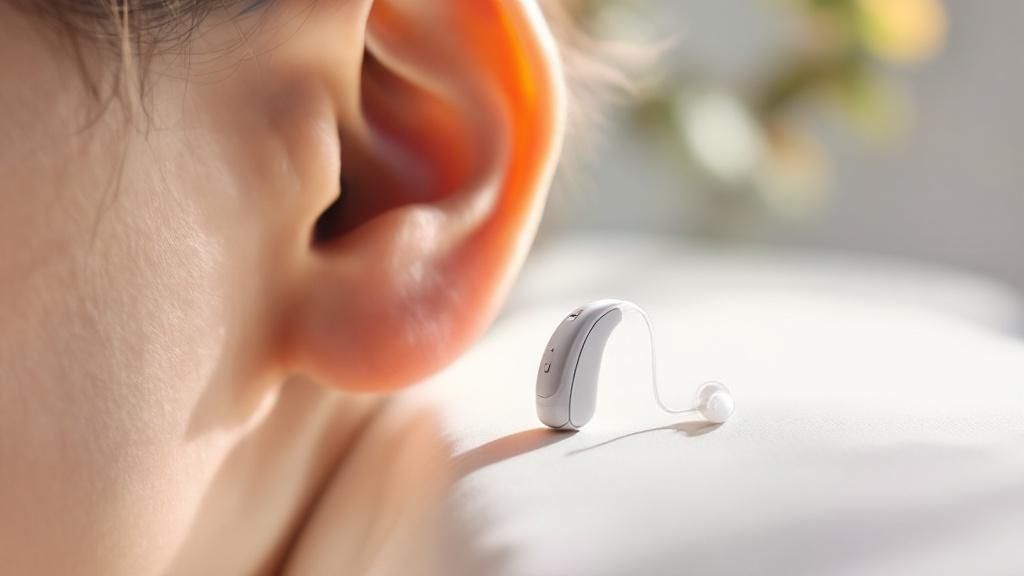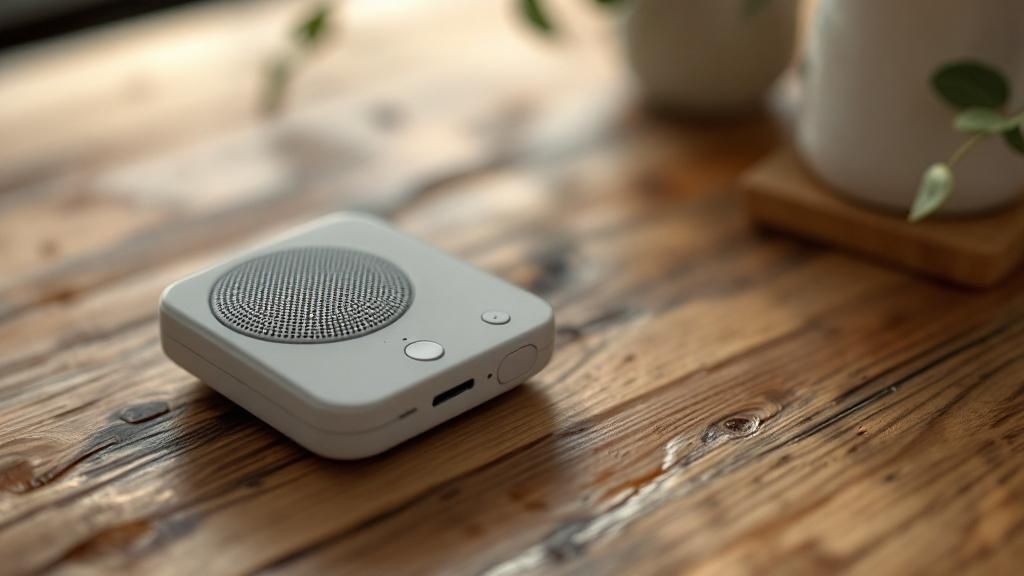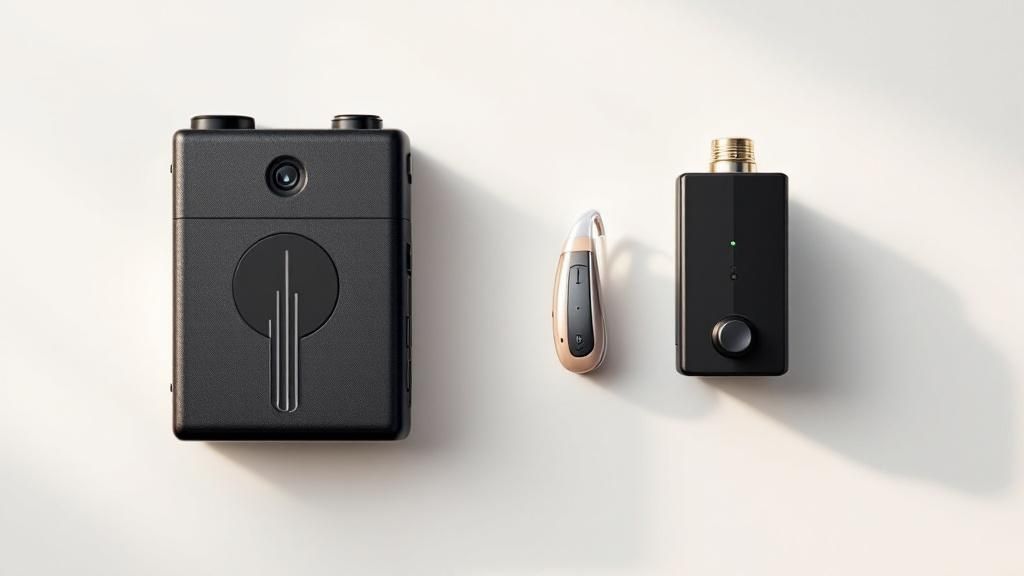Imagine this for a moment. You’re at a table, surrounded by the warm buzz of conversation, the clink of glasses, the murmur of music. A friend leans in to share a secret, a joke just for you. You see their lips move, you see the laughter in their eyes… but the words dissolve into the background noise, lost somewhere between the clatter and the chatter.
Is the world getting quieter, or just less clear?
This single, frustrating moment is where the path splits. It’s the critical fork in the road between two profoundly different tools: the hearing aid and the hearing amplifier. One is a finely-tuned instrument designed to restore the lost notes in the symphony of your life. The other is a simple volume knob.
Choosing the right one isn't just a technical decision. It’s about deciding whether you need to turn up the volume on the entire world, or if you need to bring one precious voice back into focus.
First, You Hear the Silence. Then, You Face the Choice.
It never starts with a bang. It begins with a whisper you didn't quite catch. A punchline missed. A grandchild’s question that hangs unanswered in the air. At first, you blame the room, the background noise, the speed at which people talk.
But then, the quiet moments start to feel a little too quiet. The crisp rustle of autumn leaves underfoot sounds muffled. The gentle hum of the refrigerator fades into nothing.

This is the crossroads. This is where you realize something is missing, and the search for a solution begins. You see devices that look almost identical, promising a return to a richer world of sound. But beneath the surface, a hearing aid and a hearing amplifier are as different as a surgeon’s scalpel and a butter knife. One performs a precise, medical function. The other is a blunt instrument. This isn't just about hearing more; it's about understanding what you’re hearing.
One is a Medical Tool. The Other, a Consumer Toy.
Before we go any further, let this one idea sink in: these devices exist in two entirely separate universes, governed by different rules, for different people. Grasping this is the key.
| Feature | Hearing Aids | Hearing Amplifiers (PSAPs) |
|---|---|---|
| Primary Purpose | A medical treatment to restore clarity by amplifying specific, lost frequencies. | A recreational gadget to make quiet sounds louder for normal hearing. |
| Regulation | FDA-regulated Class I or Class II medical devices. | Unregulated consumer electronics. Like headphones. |
| Ideal User | People with diagnosed hearing loss, from mild to profound. | People with perfect hearing who want a situational boost. |
| Customization | Programmed by a professional to a user's unique hearing loss blueprint (audiogram). | One-size-fits-all. A simple volume knob for the whole world. |
This isn’t just a small distinction; it’s a chasm. It's why the hearing aids market, valued at around USD 6.7 billion, is a medical industry projected to grow at about 5.58% annually. People don't just want them; they need them. You can explore the full hearing aids market report to see the gravity of this medical field.
Imagine a Sound Engineer Living in Your Ear...
Let's go back to that buzzing restaurant. Your friend is telling you that story, their voice a delicate thread in a thick tapestry of noise—clattering dishes, the hum of the crowd, faint music overhead.
How do you pull that single thread of sound out of the chaos?
A hearing amplifier approaches this problem with the subtlety of a sledgehammer. It’s a simple megaphone for your ear. It grabs every single sound—your friend’s voice, the clatter, the hum, the music—and makes it all louder, together. It amplifies indiscriminately. For a person with normal hearing who just wants to eavesdrop on birdsong from their porch, this might be fine.
But for anyone struggling with hearing loss, a megaphone in a crowded room is a nightmare. It makes the noise noisier. The chaos becomes deafening.
…Versus a Simple Megaphone for the World.
Now, imagine something different. Imagine a tiny, brilliant sound engineer sitting at a complex mixing board, right inside your ear. That’s a hearing aid. It doesn't just turn up the world's volume. It listens, analyzes, and remixes your reality in real-time. It knows the frequency of human speech is different from the frequency of a dropped fork.
With stunning speed, it performs a delicate sonic ballet:
- It isolates and lifts only the specific frequencies of your friend's voice, the ones your hearing loss has weakened.
- It actively identifies and suppresses the distracting background noise, turning down the clatter and the hum.
This isn’t amplification. It’s sound restoration. It's why hearing aids are FDA-regulated medical devices, prescribed by a professional to treat a diagnosed condition. They are tailored to your unique hearing blueprint. A hearing amplifier is just an unregulated gadget, more like a pair of binoculars for your ears than a pair of prescription glasses.
An amplifier makes the entire world louder. A hearing aid makes your world clearer.
Let's make this perfectly clear.
Hearing Aids vs Hearing Amplifiers: The Unmistakable Divide
This table cuts through the noise, revealing the core identity of each device.
| Attribute | Hearing Aids | Hearing Amplifiers (PSAPs) |
|---|---|---|
| Primary Purpose | To compensate for diagnosed hearing loss by clarifying and selectively boosting specific sound frequencies. | To make environmental sounds louder for individuals with normal hearing. |
| Regulation | Regulated as Class I or Class II medical devices by the FDA. | Unregulated consumer electronics. |
| Ideal User | Individuals with a diagnosed hearing loss (mild to profound) who need sound clarity, not just volume. | People with no hearing loss who want to amplify faint sounds in specific situations (e.g., bird watching). |
| Customization | Programmed by a hearing professional to match the user's specific hearing loss profile. | One-size-fits-all amplification. Users can only adjust the overall volume. |
| Technology | Sophisticated digital processors, directional microphones, noise reduction, feedback cancellation. | Basic amplification circuitry. |
One is a medical solution, a key to unlock lost conversations. The other is a consumer gadget, a fun tool for hobbies. They may look alike, but they could not be more different.

The chasm in their technology is vast. One is a simple circuit; the other is a tiny supercomputer. The technology of noise reduction in hearing aids alone is a world away from anything an amplifier can do. One enhances an experience. The other restores a fundamental human connection.
Now, Let’s Open Them Up and See What’s Really Inside.
Feel the weight of one in your palm. It seems so simple. But inside that tiny shell is where the magic—or the lack thereof—truly happens. What’s going on under the hood is what separates a life-changing medical device from a simple gadget.
Let’s step back into that bustling café. Imagine you could shrink down and look inside each device at that exact moment.

Inside a hearing amplifier, you’d find a ghost town. Just three basic parts: a microphone, a simple amplifier circuit, and a speaker. Its entire reason for being is to make everything that enters the microphone louder.
So in that café, the hiss of the espresso machine, the clatter of plates, and your friend's voice all get mashed together and turned up to eleven. The result is an overwhelming, muddy wall of sound. You're left more confused than before. This is why amplifiers can actually make understanding speech harder for someone with hearing loss.
A Tiny Computer That Remixes Your Reality
Now, let's peek inside a modern hearing aid. It’s not a ghost town; it's mission control. It's a tiny, intelligent computer running a constant stream of complex calculations to rebuild your soundscape. It’s a team of miniature specialists working in perfect harmony.
Here’s who’s on that team:
- Multi-Channel Compressors: Imagine a soundboard with dozens of tiny sliders instead of one big volume knob. Each slider controls a different frequency. The hearing aid adjusts them all independently, moment by moment, based on your hearing prescription.
- Directional Microphones: These are like smart spotlights for sound. They can zoom in on the voice in front of you while dimming the distracting noises from the sides and back. This is the key to hearing in a crowd.
- Feedback Cancellers: This specialist is on constant alert for the annoying whistling or buzzing that used to plague older devices, eliminating it before you ever hear it.
- Tinnitus Maskers: For those who experience a persistent ringing, this feature introduces a gentle, therapeutic sound that helps the brain ignore the tinnitus, bringing a sense of peace.
These components work together to create a listening experience that feels utterly natural, and is tailored precisely to you.
Back in the Café, the World Snaps into Focus.
Okay, you’re back in the café, now with the hearing aid. Your friend starts to speak. Instantly, the directional microphones identify their voice as the primary source and lock on.
Simultaneously, the multi-channel compressors get to work. They recognize the high-frequency clatter of dishes and the low-frequency hum of the crowd. Knowing your hearing profile, they intelligently suppress those unwanted sounds while only boosting the specific vocal frequencies you struggle with.
The result is astonishing. The background noise doesn't just get quieter; it recedes, like a tide going out. Your friend's voice lifts out of the sonic fog, becoming crisp, clear, and effortless to understand.
This is the ultimate difference in the hearing aids vs hearing amplifiers debate. One is a blunt instrument. The other is a precision tool engineered to give you back the pieces of your world you’ve been missing.
One is a Purchase. The Other is a Partnership.
Getting a device to help you hear better is a journey. But the path you walk to get a hearing aid versus an amplifier is profoundly different. One is a simple, anonymous transaction. The other is a guided, clinical process built on human expertise.
Buying a hearing amplifier is like buying headphones online. You browse, you compare specs, you click "add to cart." It arrives in a box. There is no diagnosis, no professional consultation, no personalization. It's a consumer gadget, sold like any other.
The journey for a hearing aid, however, doesn't start with a shopping cart. It starts with a conversation.
The Clinical Path to a Clearer World
This is a medical journey, designed from the ground up to diagnose and treat a specific health condition. It’s a partnership between you and a hearing healthcare professional.
Here are the essential steps on that path:
- Professional Consultation: You begin by meeting with a licensed audiologist or hearing instrument specialist—an expert who understands the intricate science of hearing.
- Comprehensive Hearing Evaluation: You'll undergo a painless, thorough hearing test. The result is an audiogram, a precise map of your unique hearing ability across the full spectrum of sound.
- Personalized Recommendation: Using your audiogram as a blueprint, the professional recommends a hearing aid that fits your specific loss, your lifestyle, and your preferences.
- Custom Fitting and Programming: This is the most critical step. The device is fitted to your ear and then meticulously programmed to match the exact specifications of your audiogram. It is tuned to restore only what you've lost.
This deliberate, data-driven process is what makes a hearing aid a true medical device. Its power comes from this deep personalization.
Acquiring an amplifier is like grabbing reading glasses off a drugstore rack. Getting a hearing aid is like having an optometrist conduct a full eye exam and craft a custom prescription lens just for you.
Why the Price Reflects a Different Reality
This deep difference in process and technology naturally creates a deep difference in cost. The price of a hearing aid isn't just for the device; it’s for the entire ecosystem of care that makes it work.
The cost includes the billions of dollars in R&D, the clinical trials, and the indispensable professional services of testing, fitting, and follow-up care. You are investing in a comprehensive hearing health solution. Amplifiers, by skipping every single one of these steps, can be sold for a fraction of the price because they deliver a fraction of the value.
The market data tells the story. The hearing aids market is a medical juggernaut projected to reach USD 14.42 billion by 2030. The hearing amplifier market, valued around USD 80.66 million, is a tiny niche by comparison. You can discover more insights about the hearing amplifier market trends to see the scale.
For a deeper dive into this journey, our guide on how to buy hearing aids provides a clear roadmap.
Are You a Robert, or a Susan? Your Story is the Answer.
Let’s bring this home. The real difference between hearing aids vs hearing amplifiers isn't about technology or regulations. It's about people. It’s about the life you’re trying to live. Let's meet two people whose stories will make your choice crystal clear.
Meet Robert. He’s a grandfather whose greatest joy is the chaotic energy of Sunday family dinners. But lately, a frustrating fog has descended. He sees his grandkids’ excited faces, but their high-pitched voices are lost in the shuffle. He finds himself just smiling and nodding, feeling like an outsider at his own table, disconnected from the laughter he loves.
Robert doesn't just need more volume. He needs more clarity. He has age-related hearing loss, a medical condition where specific frequencies have faded. For him, a hearing amplifier would be poison. It would make the clatter of forks and the background chatter just as loud as his grandkids' voices, creating an unbearable wall of noise.
Robert doesn’t need a megaphone. He needs a precision instrument that can find the lost frequencies of his family’s voices, lift them out of the noise, and place them gently back into his world. A professionally programmed hearing aid is his only path back to connection.
A Different Story Demands a Different Tool
Now, meet Susan. She's a passionate bird watcher with medically certified normal hearing. Her bliss is a quiet morning in the woods, listening to the forest awaken. She simply wants to enhance that experience—to catch the faint, high-pitched call of a distant warbler, or the subtle rustle of a deer in the undergrowth.
Susan isn't correcting a deficit. She’s augmenting a strength. For her, a hearing amplifier is the perfect tool. It’s like binoculars for her ears, bringing the quiet sounds of nature closer. It’s a recreational gadget for a specific hobby.
See yourself in their stories? This is the key.
- Are you like Robert? Missing pieces of conversation, straining in noisy places, feeling a growing sense of isolation? This is a medical journey that points directly to a hearing aid.
- Or are you like Susan? Hearing perfectly well, but wanting a situational boost for a quiet hobby? This is the exact scenario an amplifier was made for.
The consumer market for amplifiers is growing, valued at USD 108.21 million and expanding. You can explore the latest hearing amplifier market research for more. But it serves a fundamentally different need.
Your story, your struggles, and your goals will illuminate the right path. Our guide on how to choose hearing aids can help you write the next chapter.
The Most Important Sound is the One You Hear Next.
We’ve dissected the technology, walked the clinical path, and lived inside the stories. But all of this complex information boils down to one simple, powerful action. The most important step in your hearing journey isn't buying a device.
It's getting an answer.

If you find yourself turning up the TV, asking people to repeat themselves, or shying away from noisy restaurants, the single most powerful thing you can do is schedule a professional hearing test. This one step cuts through all the marketing noise and speculation. It replaces fear and frustration with data and direction.
It's the only way to know for certain what you're truly dealing with.
Treatment or Enhancement? The Final, Unmistakable Word.
At the end of the day, the distinction is absolute. One is a medical treatment. The other is a lifestyle enhancement.
Hearing aids are prescribed by professionals to restore the clarity of sound for people with diagnosed hearing loss, reconnecting them to their lives. Hearing amplifiers are consumer gadgets that make quiet sounds louder for people who can already hear normally.
Understanding this is everything. It turns a confusing choice into a clear path forward. It’s the difference between fumbling in the dark and switching on the light. This is about more than just technology; it’s about reclaiming the sounds that define your world—the whispered secrets, the shared laughter, the music you thought you'd lost forever.
Choose to bring your life back into focus.
Your Questions, Answered with Absolute Clarity
Navigating the world of sound can be confusing. Let’s cut through the fog surrounding the hearing aids vs hearing amplifiers debate and get to the truth.
Can I just try an amplifier for my mild hearing loss?
It’s the most common temptation: a cheap, easy first step. But using an amplifier to "test the waters" of hearing loss is like trying to fix a complex astigmatism with drugstore reading glasses. It makes things bigger, but not clearer.
An amplifier boosts everything equally—the background noise, the clatter, the hum—right along with the voice you're trying to hear. This often creates more confusion, not less. More importantly, it can delay you from getting a proper diagnosis and a solution that will actually work, letting your hearing and your social connections worsen over time.
Using an amplifier for hearing loss doesn't just fail to solve the problem; it makes the problem louder. Start with a professional who can give you a real answer.
Do I absolutely need a prescription for hearing aids?
Traditionally, yes. The gold standard involves a professional hearing test and a custom fitting to program the device to your exact hearing profile.
However, the landscape has evolved. A category of over-the-counter (OTC) hearing aids now allows adults with perceived mild-to-moderate hearing loss to purchase devices directly, without a prescription. This provides a more accessible starting point for many.
Why is there such a huge price difference?
The cost reflects the world of difference in what you're actually getting. An amplifier is a simple gadget. A hearing aid is a comprehensive hearing health solution.
The price of a hearing aid covers a vast ecosystem of value:
- A Tiny Supercomputer: Advanced technology like multi-channel processing, feedback cancellation, and directional microphones that can isolate a single voice in a noisy room.
- Professional Expertise: The cost includes the invaluable time and skill of an audiologist for testing, custom programming, and follow-up adjustments to ensure a perfect fit for your life.
- A Bespoke Solution: A hearing aid is tuned to your unique audiogram, restoring the specific frequencies you've lost, not just blasting you with indiscriminate volume.
An amplifier is a one-size-fits-all product. A hearing aid is a personalized medical instrument designed to reconnect you to the sounds, the people, and the life you love.
Ready to experience a world of clear, crisp sound without the clinic visit? HearDirectClub offers FDA-registered, nearly invisible hearing aids pre-programmed for mild-to-moderate hearing loss. Enjoy advanced noise reduction, a 100-day risk-free trial, and 24/7 expert support. Reconnect with the conversations you've been missing by visiting https://heardirectclub.com today.

